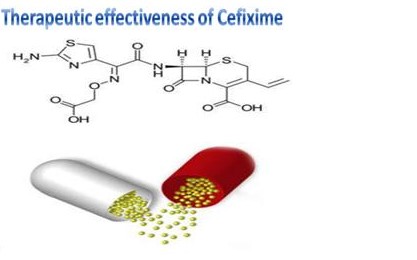
Therapeutic effectiveness of Cefixime
Therapeutic effectiveness of Cefixime
We all are familiar with Antibiotics, their effectiveness in several bacterial infections. These antibiotics are classified as broad spectrum and narrow spectrum. Various classes and subclasses of antibiotics are effective against different types of bacteria. Cefixime is one of the majorly used antibiotics in numerous bacterial infections. It comes under the class of broad-spectrum antibiotics, which means it is effective against a wide variety of different types of bacteria. Cefixime is the third generation cephalosporin antibiotic. Cefixime was approved for medical use in the United States in 1989. It is on the World Health Organization’s List of Essential Medicines, the most effective and safe medicines needed in a health system.
How Cefixime kills the bacteria?
Antibiotics are also classified as bactericidal and bacteriostatic. Cefixime comes under bactericidal antibiotic. It works by interfering with the formation of the bacterial cell wall. Cefixime binds to specific penicillin-binding proteins (PBPs) located inside the bacterial cell wall. Moreover, it inhibits transpeptidase which prevents cross-linking of the bacterial cell wall. Inhibition in the cell wall formation leads to the death of bacteria.
Cefixime is much stable in the presence of β-lactamase enzymes hence many organisms resistant to penicillin’s and some cephalosporins may be susceptible to Cefixime. It is highly active against gram-negative cocci, gram-negative bacilli and anaerobes than gram-positive cocci and bacilli. It is not active against pseudomonas
Cefixime is effective against:
Gram-positive
- Streptococcus pneumoniae
- Streptococcus pyogenes
Gram-negative Organisms
- E.coli
- H. influenzae
- Moraxella catarrhalis
- Proteus mirabilis
- N. gonorrhea
Cefixime is used in the various infections
- Tonsillitis
- Pharyngitis
- Otitis media
- Bronchitis
- Urinary tract infections
- Gonorrhea
Cefixime has been studied in numerous clinical trials for different bacterial infections. Cefixime found effective in these clinical trials. It has been found in a clinical study that was held in Japan that complicated urinary tract infection treated with a daily divided dose of Cefixime 200mg or a single dose of 400mg.
It has been found in the multicenter trial in Germany that Cefixime at a dose of 400mg orally for 5-10 days gives a significant improvement of the patients suffering from acute bronchitis. As compared to amoxicillin, the improvement rate of patients of respiratory infections who were treated with 400mg Cefixime is much larger than amoxicillin.
In comparison with penicillin, Cefixime is more effective in the treatment of Pharyngitis. An open-label randomized trial was conducted to compare the efficacy and safety of Cefixime, 8 mg/kg once daily and penicillin V, 250 mg 3 times daily. At the end of the therapy, the bacteriologic eradication rate of Cefixime was 97% and in case of Penicillin, it was 77% which shows that Cefixime is much effective than penicillin in Pharyngitis.
Even a single dose of 400 mg of Cefixime at once provides a remarkable improvement in Gonorrhea. It has also noted that Cefixime also effective in otitis media at a dose of 8mg/kg/day when it has been given to the children at the age of 6-12 years old for 10-14 days.
Typhoid fever is most common in developing countries. Various clinical trials are conducted on the efficacy of Cefixime in typhoid fever. An open-labelled, non-comparative, study was conducted in 112 subjects to evaluate the efficacy and safety of Cefixime on typhoid fever in multiple hospitals of Nepal. A dose of 200mg of Cefixime was given twice to the patients for 7 days. A significant reduction was seen in patients at the end of the study. This study proves that Cefixime is safe and efficacious for the treatment of typhoid fever.
Cefixime is regarded as a safe drug. It can also prescribe to pregnant as well as breastfeeding women. Any carcinogenic and mutagenic activity doesn’t report yet in the various animal as well as in vitro studies.
References
https://europepmc.org/abstract/med/1454432
https://link.springer.com/article/10.1007/BF01742990
https://aac.asm.org/content/45/9/2450.short
https://link.springer.com/article/10.2165/00003495-199549060-00010
https://www.tandfonline.com/doi/abs/10.1080/1120009X.1989.11738903
https://www.amjmed.com/article/0002-9343(88)90457-3/fulltext
https://www.amjmed.com/article/0002-9343(88)90457-3/fulltext


Leave a Comment
(0 Comments)